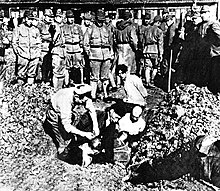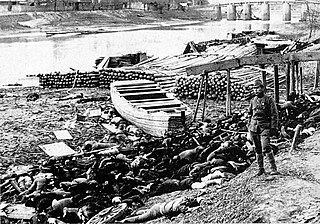
The Nanjing Massacre or the Rape of Nanjing was the mass murder of Chinese civilians in Nanjing, the capital of the Republic of China, immediately after the Battle of Nanking and the retreat of the National Revolutionary Army in the Second Sino-Japanese War, by the Imperial Japanese Army. Beginning on December 13, 1937, the massacre lasted six weeks. The perpetrators also committed other war crimes such as mass rape, looting, torture, and arson. The massacre is considered to be one of the worst wartime atrocities.

The Battle of Nanking was fought in early December 1937 during the Second Sino-Japanese War between the Chinese National Revolutionary Army and the Imperial Japanese Army for control of Nanjing (Nanking), the capital of the Republic of China.
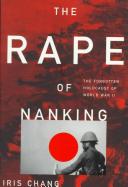
The Rape of Nanking: The Forgotten Holocaust of World War II is a bestselling 1997 non-fiction book written by Iris Chang about the 1937–1938 Nanjing Massacre — the mass murder and mass rape of Chinese civilians committed by the Imperial Japanese Army in Nanjing, the capital of the Republic of China, immediately after the Battle of Nanjing during the Second Sino-Japanese War. It describes the events leading up to the Nanjing Massacre, provides a graphic detail of the war crimes and atrocities committed by Japanese troops, and lambastes the Japanese government for its refusal to rectify the atrocities. It also criticizes the Japanese people for their ignorance about the massacre. It is one of the first major English-language books to introduce the Nanjing Massacre to Western and Eastern readers alike, and has been translated into several languages. The book significantly renewed public interest in Japanese wartime conduct in China, Korea, Southeast Asia and the Pacific.

The Chairman Mao Memorial Hall, also known as the Mausoleum of Mao Zedong, is the final resting place of Mao Zedong, Chairman of the Politburo of the Chinese Communist Party from 1943 and the Chairman of the Chinese Communist Party from 1945 until his death in 1976.

The Nanjing Metro is a rapid transit system serving the urban and suburban districts of Nanjing, the capital city of Jiangsu Province in the People's Republic of China.

The Memorial to the Civilian Victims of the Japanese Occupation, usually called the Civilian War Memorial, is a war memorial and heritage landmark in Singapore next to Esplanade MRT station. It was built in memory of the civilians killed during the Japanese occupation of Singapore during World War II. The Civilian War Memorial sits on serene parkland in the midst of busy city traffic near Singapore's Padang and City Hall. Located within the War Memorial Park at Beach Road within the Central Area, Singapore's central business district, it is usually easy to spot in most backdrops encompassing the CBD landscape. It was gazetted as the 65th national memorial on 15 August 2013.

The Memorial Hall of the Victims in Nanjing Massacre by Japanese Invaders is a museum to memorialize those that were killed in the Nanjing Massacre by the Imperial Japanese Army in and around the then-capital of China, Nanjing, after it fell on December 13, 1937. It is located in the southwestern corner of downtown Nanjing known as Jiangdongmen (江东门), near a site where thousands of bodies were buried, called a "pit of ten thousand people".
Qi Kang, is a Chinese architect, also an artist. He is a supervisor in Southeast University, Academician of Chinese Academy of Sciences, Foreign Academician of French Academy of Architecture, and Director of Research Institute of Architecture of Southeast University.

Yuhuatai Memorial Park of Revolutionary Martyrs (雨花台烈士陵园) is a park and tourist site in the Yuhuatai District of Nanjing, Jiangsu Province, China. The name Yuhuatai comes from yu (rain), hua (flower), tai (platform). A prominent feature of the park is a statue of nine figures. The statue commemorates the Chinese Communist Party members killed by the Kuomintang.
Tokushi Kasahara is a Japanese historian. He is a professor emeritus at Tsuru University and his area of expertise is modern Chinese history.
Tamaki Matsuoka is a Japanese activist who challenges Japanese perceptions of the country's war crimes in the Rape of Nanjing during Second Sino-Japanese War.
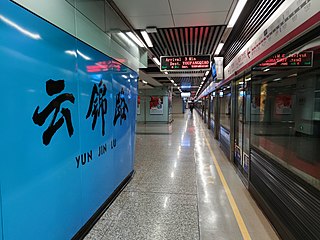
Yunjinlu station, is a station of Line 2 of the Nanjing Metro. It started operations on 28 May 2010 along with the rest of Line 2.

Yang Weize is a former Chinese politician. He was the Communist Party Secretary of Nanjing, capital of Jiangsu Province, from 2011 to 2015. Prior to that, he served as the party secretary in the neighbouring city of Wuxi for seven years, and before that the Mayor of Suzhou. In 2015, Yang was put under investigation for corruption by the Central Commission for Discipline Inspection. He was tried and convicted on corruption charges and sentenced to twelve years and six months in prison in December 2016.
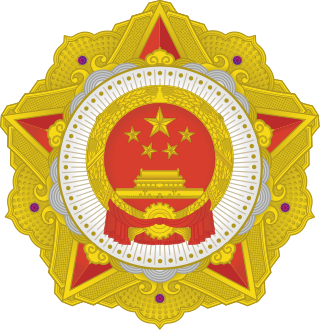
The Medal of the Republic is the highest honorary medal of the People's Republic of China. The bestowal is decided by the Standing Committee of the National People's Congress and presented by the President of China. According to law, this medal is bestowed on "outstanding individuals who have made great contributions and established outstanding merits in the construction of socialism with Chinese characteristics and defense of the country."

The Tsunami Advisory Center of the Ministry of National Resources is a Chinese administrative agency that aims to mitigate tsunami damage in the coastal areas of China. The agency is also known as the UNESCO Intergovernmental Oceanic Committee South China Sea Regional Tsunami Warning Center, which is abbreviated as the South China Sea Tsunami Advisory Center (SCSTAC). It was founded in 2013 and is a subsidiary of the Ministry of Natural Resources of the People's Republic of China and the National Marine Environmental Forecasting Center.

The tomb of Lu Xun is the burial place of the Chinese writer Lu Xun (1881–1936), located in the northwestern corner of the Lu Xun Park in Hongkou District, Shanghai. Covering an area of 1,600 square metres (17,000 sq ft), the tomb of Lu Xun was built in 1956, and in the same year, the remains of Lu Xun was moved to this tomb from the Wanguo Cemetery of Shanghai.
Martyrs' Day is celebrated in China on September 30, the eve of the National Day of the People's Republic of China, to commemorate those who lost their lives serving China. It was created by the Standing Committee of the National People's Congress in 2014.
The Nanjing Historical & Cultural Cities Expo is an international cultural event held in Nanjing, China. The expo is held every two years, and the first one was held in 2004. The meeting is sponsored by the Ministry of Culture, Ministry of Housing and Urban-Rural Development of the People's Republic of China, National Cultural Heritage Administration and the National Commissions for UNESCO, and undertaken by Nanjing Municipal People’s Government, Jiangsu Provincial Department of Culture and Tourism, Jiangsu Provincial Department of Housing and Urban-Rural Development... From the first to the eighth, 276 domestic and foreign cultural city mayors from 74 countries and regions participated. In May 2013, the Organizing Committee of Famous City Club and UNESCO has signed a strategic cooperation agreement.

The Nanjing Ring Expressway, designated as G2503, is ring expressway in Nanjing, Jiangsu, China.

The Aviation Martyrs' Cemetery is one of the most important historical sites and representative buildings of modern times in Jiangsu Province. It is located in the northern part of Zhong Shan in Nanjing, Jiangsu Province, and was built in 1932, with pagodas, a pavilion, an altar, and a cemetery. There are 4,296 martyrs in the cemetery, including R.O.C. Airmen who died in the Northern Expedition and the Shanghai War of the National Revolutionary Army, Chinese and foreign airmen who died in the War of Resistance against Japan, and R.O.C. Airmen who died in the civil war between China and the Communist Party. Some of the martyrs have a tomb with their clothes, while the rest have their names, origins, and dates of birth and death inscribed on the memorial. The Aviation Martyrs' Cemetery was burned down by the invading Japanese army during the war and was rebuilt to its pre-war condition after the war. Later, the cemetery was completely destroyed by the Red Guards during the Cultural Revolution, all the skeletons were lost and reconstructed in 1987.

